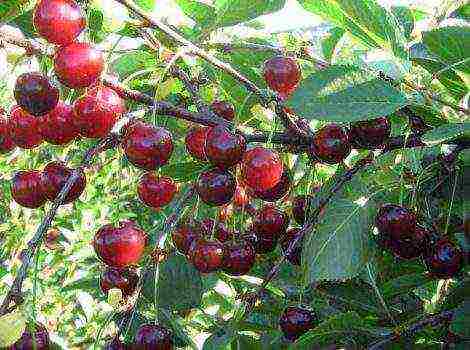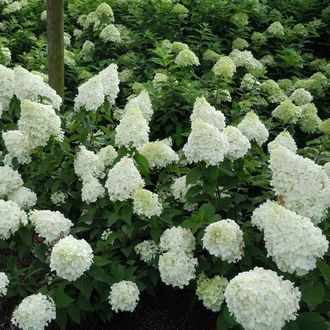Content
- 1 Hardy
- 2 Red-cheeked
- 3 Darling
- 4 Honey
- 5 Russian
- 6 Snegirek
- 7 Triumph North
- 8 Which winter-hardy variety of apricots should you choose?
- 9 Which self-fertile apricot variety should you choose?
- 10 What varieties of apricots are resistant to moniliosis?
- 11 Which columnar apricot variety should you choose?
- 12 What varieties are there by ripening time?
- 13 Conclusions about the best varieties of apricot
With the advent of winter-hardy varieties, apricot ceased to be exotic, because today in central Russia you can independently grow a fruiting tree on a site. The main thing is to choose the right variety.
In the central regions of Russia, the climate is unstable. In winter and early spring, fastidious crops (including apricots) can freeze slightly, and then you should not expect a rich harvest. But you really want to taste delicious, juicy and healthy fruits!
Plant cold and frost-resistant apricots in your garden. And then, with proper care of the plant, you will be able to get a good harvest.
Hardy
The name of this apricot variety speaks for itself. The plant easily adapts to unfavorable conditions, while not only the tree itself is not afraid of severe frosts (due to the fact that it has a thick bark), but also its buds, which in other varieties often die during spring frosts.
The tree grows quite large in a short period of time, but begins to yield only 5-6 years after planting. The fruits are medium in size, round in shape and golden in color with a coral shade. The skin is slightly pubescent, the flesh is very sweet and aromatic, orange in color.
| Appointment | Harvest | Tree height (m) | Fruit weight (g) | Productivity (kg per tree) |
|
1st decade August |
5 | 30-45 | 60-80 | |
Red-cheeked
This winter-hardy apricot was bred in 1947 and over time has become very popular with summer residents. The variety has good yields and the ability to adapt to unfavorable conditions. To preserve these important qualities, such popular hybrids as Nikitinsky, Nikolaevsky, Son of Krasnoshcheky, Krasnoshcheky Salgirsky and others were bred on the basis of Krasnoshcheky.
Red-cheeked is a mid-season variety. The tree grows medium in size, with a spreading, rounded crown. The fruits ripen round or ovoid, their skin is pubescent, golden-orange with a slight reddish blush. The pulp is very tasty, sweet and sour, aromatic.
The advantage of this variety is also the fact that the tree begins to bear fruit already 3-4 years after planting the seedling.
| Appointment | Harvest | Tree height (m) | Fruit weight (g) | Productivity (kg per tree) |
|
2nd half july |
4-5 | 40-60 | up to 90 | |
Darling
The tree of this variety grows very quickly and reaches a height of 5 m. It is distinguished by a paniculate crown and straight shoots of medium thickness. Already 3-4 years after planting, fragrant fruits with a bright yellow skin covered with red dots and sweet and sour yellow pulp ripen on the plant.
The Favorite variety is resistant not only to frost, but also to diseases, pests and bright sun.
| Appointment | Harvest | Tree height (m) | Fruit weight (g) | Productivity (kg per tree) |
|
1st half August |
4,5-5 | 25-30 | 50-60 | |
Honey
The tree of this variety can reach a height of 4 m and has a voluminous and spreading crown. Small fruits grow on it. Their skin is yellow, with small red dots and slight pubescence. The pulp is of medium density, yellow in color, fibrous-granular and sweet in taste.
The Medovy variety without shelter can withstand a drop in temperature to –35 ° С, and in snowy winters - and all –40 ° С.
| Appointment | Harvest | Tree height (m) | Fruit weight (g) | Productivity (kg per tree) |
|
1st half August |
2-4 | 15 | 15-20 | |
Russian
The tree of this variety grows rather low, it is convenient to harvest from it. At the same time, without shelter, it is able to withstand frosts down to –30 ° С.
The fruits ripen round, orange in color, with excellent taste. Their flesh is deep yellow, tender and very juicy. The tree begins to bear fruit in the 5-6 year field of planting.
| Appointment | Harvest | Tree height (m) | Fruit weight (g) | Productivity (kg per tree) |
|
Mid july |
3,5-4 | 60-65 | 80 | |
Snegirek
This is the undoubted leader in winter hardiness. With light cover, Snegirek apricots are grown even in the North. Not only is this small tree (up to 1.5 m high) not afraid of frosts (including spring ones, since it blooms late), but it still grows well on any soils, even not very fertile ones.
This variety has other advantages: the fruits are very elastic, therefore they are well stored (until mid-winter) and are not damaged during transportation. Their color is light yellow with a burgundy blush, the pulp is sweet, juicy and aromatic, but sometimes it can taste a little bitter near the skin.
However, Snegirek still has one drawback: it is not resistant to diseases such as leaf spot and moniliosis. If it often rains in the spring and summer, the tree needs careful maintenance and regular treatments (for example, with Xopyc 75WY) in order to prevent the development of dangerous diseases.
| Appointment | Harvest | Tree height (m) | Fruit weight (g) | Productivity (kg per tree) |
|
Middle August |
1,2-1,5 | 15-18 | 7-10 | |
Triumph North
This winter-hardy variety was obtained by crossing two hardy varieties: Krasnoshchekiy and Severny early. On a tree with a spreading crown, branches are located at an angle of 45-50 degrees.
The fruits are rather large, round or oval in shape, may be slightly flattened. The peel of apricots is slightly pubescent, the taste is slightly sour, yellow-orange in color with a red-burgundy blush. The pulp of the fruit is orange, very juicy, sweet and tender.
And that's not all the pluses of the Northern Triumph! The flower buds of this tree have very good resistance to recurrent spring frosts. And the plant is also not susceptible to damping, as well as damage by dangerous pests and diseases (moniliosis, cytosporosis, verticillosis, clasterosporium).
| Appointment | Harvest | Tree height (m) | Fruit weight (g) | Productivity (kg per tree) |
|
End of July - early August |
3-4 | 40-55 | 50-64 | |
Growing a fruiting apricot tree in your own summer cottage is real! Moreover, even in an unstable and rather cold climate. Cultivate suitable winter-hardy varieties and you will succeed.
Every gardener dreams of growing an apricot tree. The fruit of this plant is of undoubted benefit. It is delicious and aromatic. It is usually eaten fresh. But it is also ideal for making preserves, compotes, jams. Having planted just a couple of apricot varieties, the summer resident will receive a rich harvest of ripe fruits. True, it is not so easy to decide on a specific variety of this fruit tree. After all, the assortment is striking in its variety. This article will describe the best varieties of apricots, which are characterized by resistance to ailments and cold.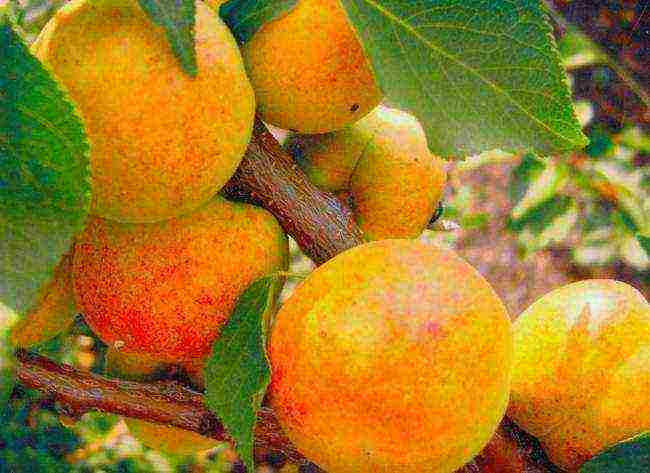
Which winter-hardy variety of apricots should you choose?
Apricot trees grow on almost every summer cottage. The plant is very thermophilic, but today, thanks to the work of breeders, a lot of cold-resistant species have appeared.  And if earlier this fruit crop was grown mainly in the southern regions, it became possible to plant apricots in areas that have a colder microclimate. Perhaps an interesting article will be about domestic and foreign early varieties of raspberries.
And if earlier this fruit crop was grown mainly in the southern regions, it became possible to plant apricots in areas that have a colder microclimate. Perhaps an interesting article will be about domestic and foreign early varieties of raspberries.
Below are the best varieties of apricot, which are characterized by increased winter hardiness:
- Hardy.
- Best Michurinsky.
- Red-cheeked.
Apricot Hardy
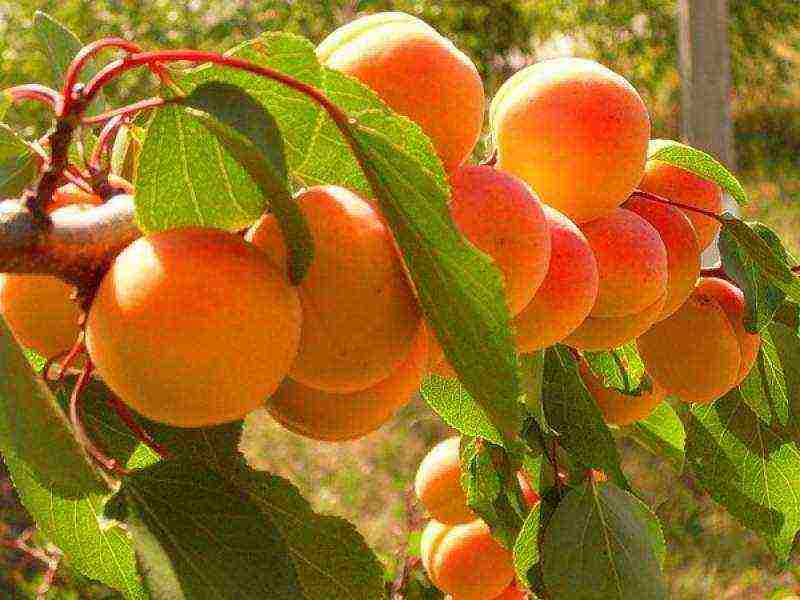 This variety is recognized as the most hardy in terms of withstanding low temperature indicators. Therefore, summer residents of the Moscow region often choose this variety. It should be noted that winter-hardy properties extend not only to the tree itself, but also to flower buds.
This variety is recognized as the most hardy in terms of withstanding low temperature indicators. Therefore, summer residents of the Moscow region often choose this variety. It should be noted that winter-hardy properties extend not only to the tree itself, but also to flower buds.
The plant is vigorous. The crown is large, rounded, medium thickened. Hardy enters fruiting 5 years after planting. The yield is high and stable. At least 70 kilograms of fruit are usually harvested from one tree. Each fruit weighs between 30 and 45 grams. The skin color is golden orange. There is a carmine blush. The pubescence of the surface is minimal. The pulp is orange. The taste is pleasant sweet. The advantages of the variety include the presence of good immunity to most ailments and the self-fertility of the plant.
Apricot Best Michurinsky
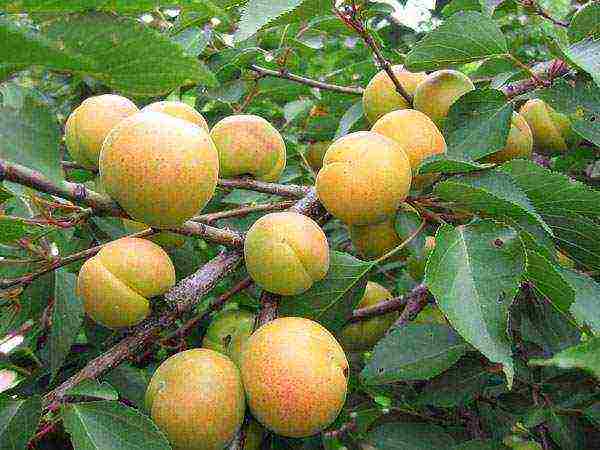 It is worth considering the description of the Apricot variety Best Michurinsky as one of the most popular at the moment. The variety is medium late. It is characterized by good yield and high winter hardiness. The best pollinator for Michurinsky is the Tovarish variety. The tree begins to bear fruit after 5 years from the moment of planting. Fruits ripen in the first decade of August. Apricots are small in size. Their weight does not exceed 15 grams. The shape is flattened-rounded. Yellow color. There is a slight blush. The pulp is dense, yellow, has a sweet and sour taste.
It is worth considering the description of the Apricot variety Best Michurinsky as one of the most popular at the moment. The variety is medium late. It is characterized by good yield and high winter hardiness. The best pollinator for Michurinsky is the Tovarish variety. The tree begins to bear fruit after 5 years from the moment of planting. Fruits ripen in the first decade of August. Apricots are small in size. Their weight does not exceed 15 grams. The shape is flattened-rounded. Yellow color. There is a slight blush. The pulp is dense, yellow, has a sweet and sour taste.
Apricot Red Cheeked
It is an inexpensive, popular apricot. It is highly appreciated by domestic summer residents for its frost resistance and unpretentiousness. The seedling takes root not only in the northern, but also in the southern climate. The tree produces large, rounded fruits. The harvest ripens in the month of July. The pulp is sweet-sour taste, pronounced aroma.
Which self-fertile apricot variety should you choose?
Self-fertility is a useful property of the apricot tree; under it, the plant's ability to self-pollinate is increased.
Due to this, the summer resident is guaranteed to receive a rich harvest, regardless of whether another fruit tree grows nearby or not. Therefore, many farmers tend to plant self-fertile apricot varieties on their personal plot.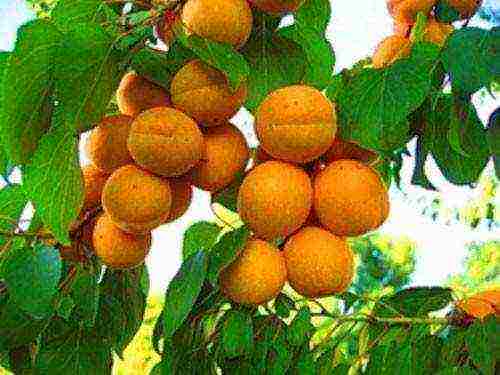
Below are the best self-fertile apricot varieties that are enjoying good popularity:
- Dessert.
- Sardonyx.
- Northern Triumph.
Apricot Dessert
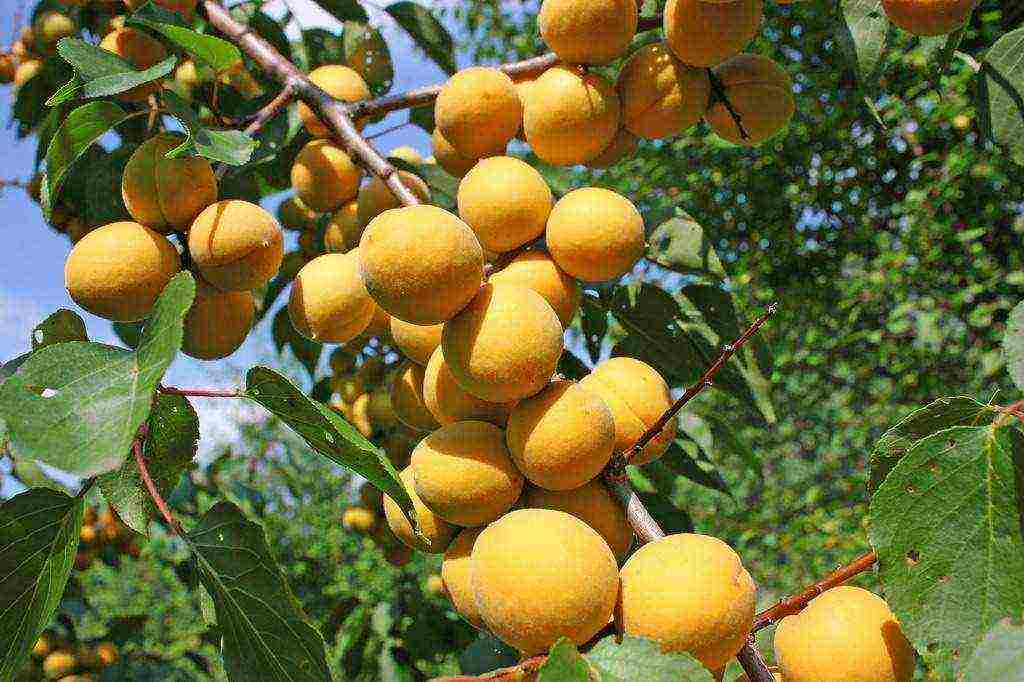 Many beginners and already experienced summer residents choose this variety. Therefore, it makes sense to consider the description of the Dessert apricot variety in more detail. A tree of medium height grows. The crown is round and rather sparse. Annual shoots are thick. In the middle lane, there is a good winter hardiness of the plant and flower buds.
Many beginners and already experienced summer residents choose this variety. Therefore, it makes sense to consider the description of the Dessert apricot variety in more detail. A tree of medium height grows. The crown is round and rather sparse. Annual shoots are thick. In the middle lane, there is a good winter hardiness of the plant and flower buds.
The fruits are medium in size. Their mass reaches 35-40 grams. The shape is rounded, strongly flattened from the sides. The surface is painted yellow. Pubescence is strong. The pulp is light orange, crispy, medium in density. The taste is pleasant, sweet. There is a hint of sourness. The aroma is pronounced. Fruits ripen in mid-July.
Apricot Triumph north
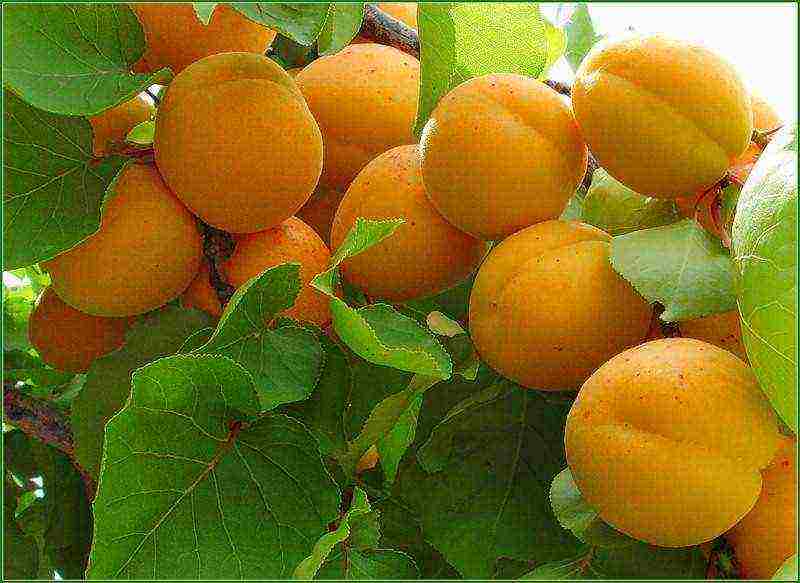 The plant is vigorous. Usually reaches 4 meters in height. The crown is wide, medium branching. The fruits are medium in size. Their weight is about 60 grams. The shape of the apricot is oval, asymmetric. Ripe fruits are colored yellow-pink. The pubescence of the skin is not strong. The pulp is juicy, sweet and sour. Triumph begins to bear fruit at the 5th year of life. From the age of 10, more than 50 kilograms of the crop are harvested from one plant.
The plant is vigorous. Usually reaches 4 meters in height. The crown is wide, medium branching. The fruits are medium in size. Their weight is about 60 grams. The shape of the apricot is oval, asymmetric. Ripe fruits are colored yellow-pink. The pubescence of the skin is not strong. The pulp is juicy, sweet and sour. Triumph begins to bear fruit at the 5th year of life. From the age of 10, more than 50 kilograms of the crop are harvested from one plant.
Numerous reviews of the Northern Triumph apricot indicate that the variety is the best for growing in Siberia. Among the advantages summer residents note self-pollination, early maturity, high productivity. However, it must be borne in mind that fruiting is very unstable.
Apricot Sardonyx
This is a medium late variety. The apricot Sardonyx ripens in early August. The tree is winter-hardy, medium-sized, fast-growing and fruitful enough. The fruits are large. They are ovoid.The average weight is 50 grams. The plant enters fruiting at the 4th year of life.
What varieties of apricots are resistant to moniliosis?
Often, apricot infects moniliosis, fungicides are used to combat this disease, however, chemical treatment of wood is not always safe.
In addition, the process becomes more difficult in rainy weather. 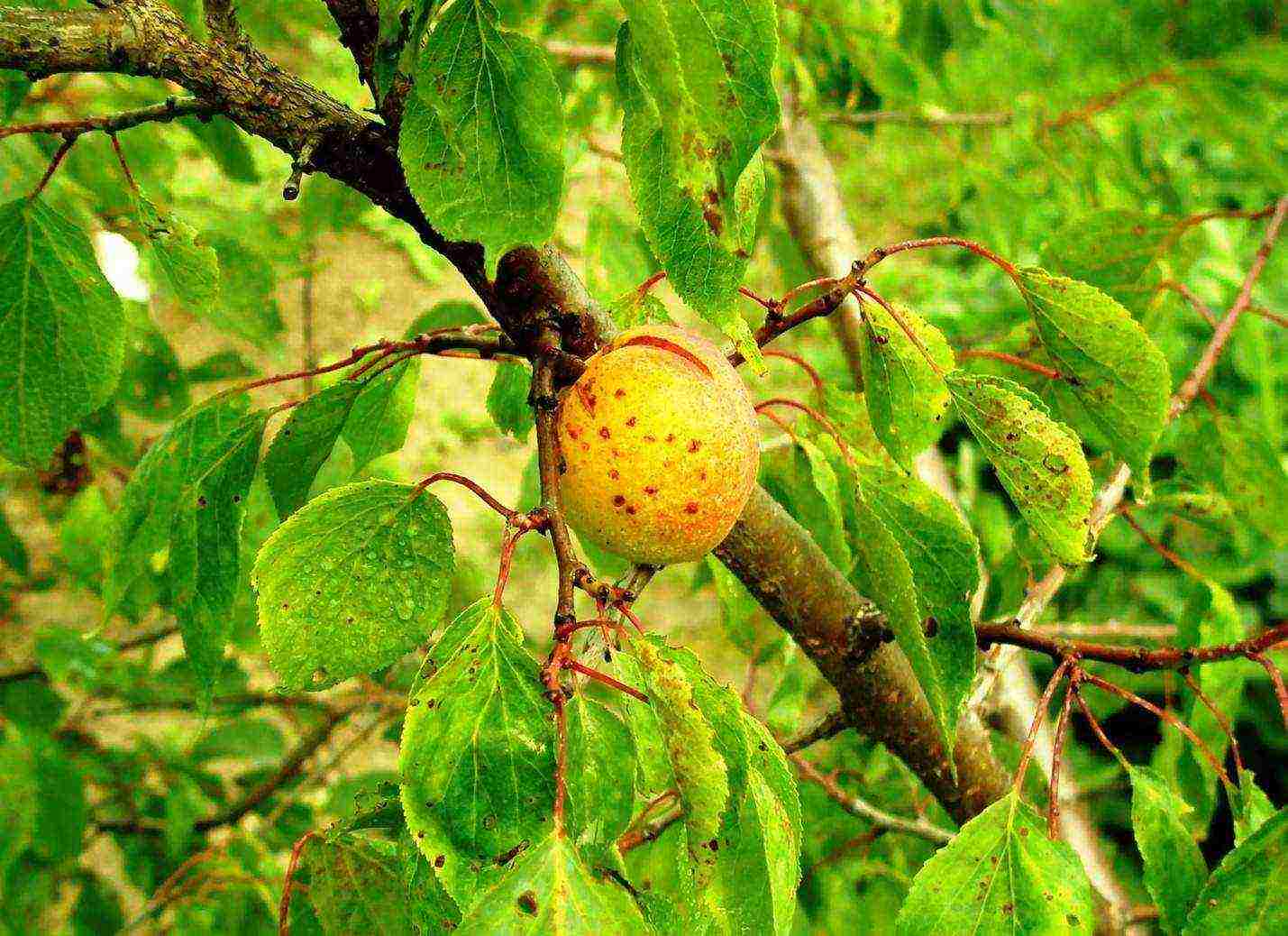 Therefore, gardeners often plant apricot varieties resistant to moniliosis in their area.
Therefore, gardeners often plant apricot varieties resistant to moniliosis in their area.
These varieties include:
- Special Denisyuk.
- Monastyrsky.
- Goldrich.
Apricot Special Denisyuk
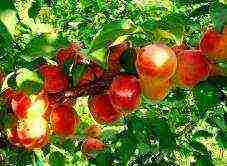 Today, many varieties are known that are immune to moniliosis. The most demanded is the Special Denisyuk. Late ripening variety. The tree is medium-sized. The crown is not particularly thickened. Productivity and winter hardiness are high. The fruits are characterized by an unusual carmine color. Largest in size. Good-tasting pulp, juicy. Ripe fruits are capable of not falling off the branches for a long period.
Today, many varieties are known that are immune to moniliosis. The most demanded is the Special Denisyuk. Late ripening variety. The tree is medium-sized. The crown is not particularly thickened. Productivity and winter hardiness are high. The fruits are characterized by an unusual carmine color. Largest in size. Good-tasting pulp, juicy. Ripe fruits are capable of not falling off the branches for a long period.
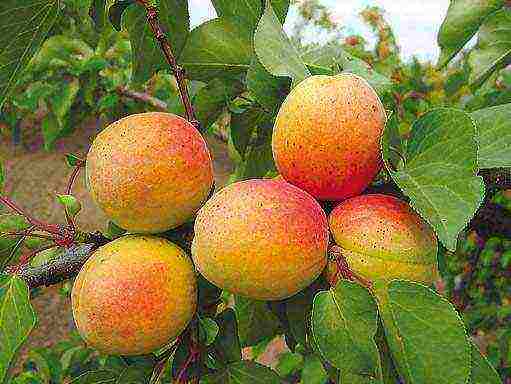 Apricot Monastic
Apricot Monastic
A variation of the average ripening period. The plant is short. The crown is round. Winter hardiness and productivity are good. The fruit is quite large. They are yellow-orange in color. There is no blush. Monastic is distinguished by its unsurpassed aroma and excellent taste. For which he was very fond of domestic gardeners.
Apricot Goldrich
The plant is medium-sized. The crown is spreading, wide. Goldrich is characterized by yield, winter hardiness, immunity to moniliosis and shark. At the moment, this is the largest-fruited variety. The apricot mass reaches 90 grams. There are specimens weighing more than 100 grams. The shape of the fruit is oval, slightly flattened on the sides. The skin is orange with a slight red blush. The pulp is firm, dark orange. The aroma is light, pleasant.
Which columnar apricot variety should you choose?
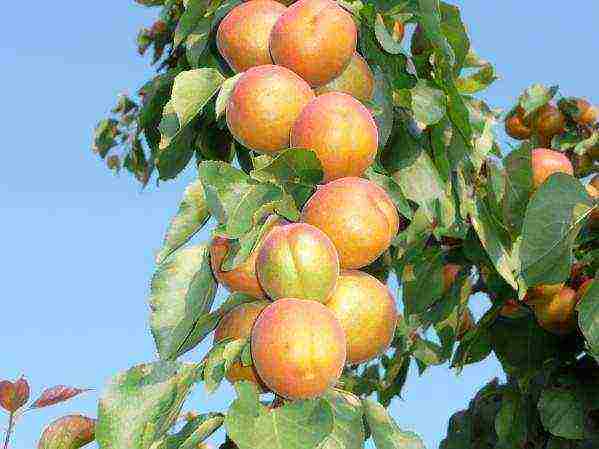 Not every summer resident can boast of a large personal plot. And everyone wants to create a garden. In the case of a limited area, it makes sense to pay attention to the columnar varieties of fruit trees. They take up little space, grow in the form of a column, from which small branches extend. Having planted the best varieties of columnar plums and apricots, the garden will look neat and beautiful.
Not every summer resident can boast of a large personal plot. And everyone wants to create a garden. In the case of a limited area, it makes sense to pay attention to the columnar varieties of fruit trees. They take up little space, grow in the form of a column, from which small branches extend. Having planted the best varieties of columnar plums and apricots, the garden will look neat and beautiful.
There are many varieties of columnar apricots. But the Prince variety is especially popular today. This is the most productive tree. The plant is early maturing, does not need a pollinator, and has excellent resistance to low temperatures and diseases. The reviews are mostly positive.
What varieties are there by ripening time?
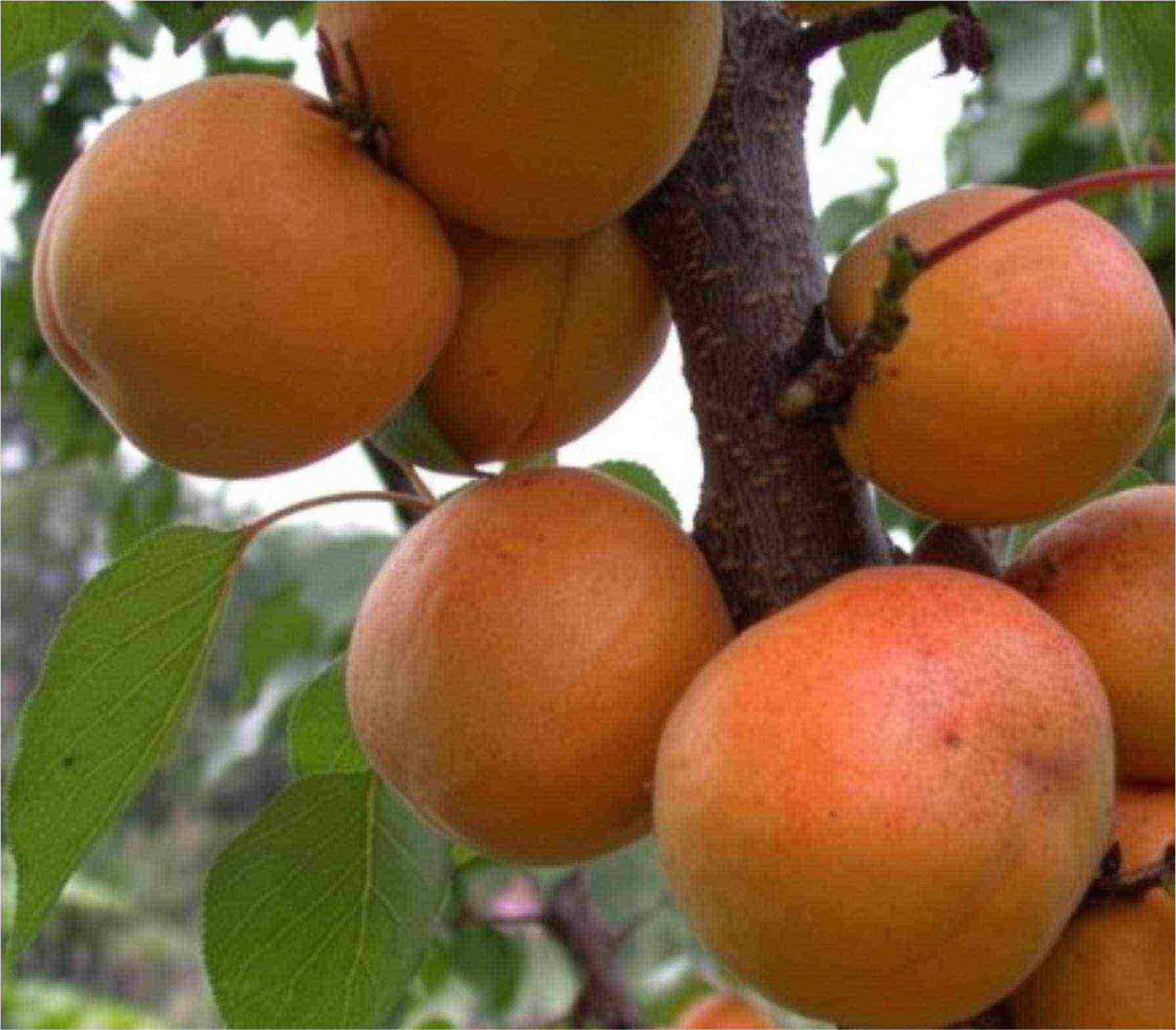 Depending on the period of fruit ripening, all apricots are divided into early ripening, mid-ripening and late-ripening. The first is the Alyosha variety. Also good reviews about apricot Zhigulevsky souvenir, June. Among mid-season varieties, Altair, Olympus, Aviator, Amur, Phelps, Aquarius are most often chosen. Having decided to plant a late variety of apricot, it makes sense to pay attention to the apricot Hargrand, Sirena, Kostyuzhensky, Iskra. It is advisable to plant several types of fruit trees with different ripening periods. Then the summer resident will enjoy fresh fragrant fruits for much longer.
Depending on the period of fruit ripening, all apricots are divided into early ripening, mid-ripening and late-ripening. The first is the Alyosha variety. Also good reviews about apricot Zhigulevsky souvenir, June. Among mid-season varieties, Altair, Olympus, Aviator, Amur, Phelps, Aquarius are most often chosen. Having decided to plant a late variety of apricot, it makes sense to pay attention to the apricot Hargrand, Sirena, Kostyuzhensky, Iskra. It is advisable to plant several types of fruit trees with different ripening periods. Then the summer resident will enjoy fresh fragrant fruits for much longer.
Conclusions about the best varieties of apricot
Thus, there are many varieties of apricot today. Despite the fact that this fruit is thermophilic, it can be easily grown even in the northern region. The main thing is to get a winter-hardy seedling. To choose the best variety, you need to understand the classification of fruit trees, the characteristics of each variety. Having decided on a specific species, you should study the features of planting and growing this crop. Usually, apricot is grafted onto plums, peaches or cherries. Look at the article: How and in what ways is a watermelon grafted onto a pumpkin?
Description of varieties of apricots: reviews, photos
This page contains the best varieties of apricots included in the State Register of Breeding Achievements of the Russian Federation.Many of them are suitable for the Moscow region and the entire central zone of Russia.
Apricot Iceberg
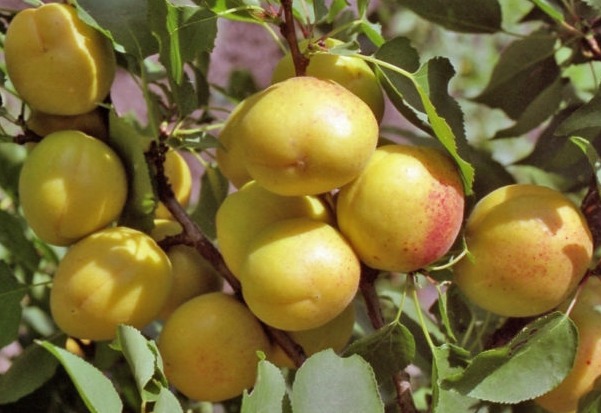
An early ripe, winter-hardy universal variety. The tree is medium-sized, fast-growing, with a paniculate raised crown of medium density. Begins fruiting in the third year. Shoots are straight, dark red, glabrous. The leaves are wide, ovate, short-pointed, dark green, smooth, shiny, with a crenate edge.
Fruits are round, with an orange main and red integumentary color, with slight pubescence, with an average weight of 20 grams. The pulp is yellow, tender, juicy, melting, mealy, sweet-sour taste. Tasting score 4 points.
Average yield: 48 centners / ha.
Moderately resistant to clotterosporium disease; aphids were damaged up to 1%.
Apricot variety Iceberg is included in the State Register for the Central Region.
Apricot Academician, characteristic

Medium ripening, winter hardy, versatile. Over the years of observation, the variety showed high winter hardiness and withstood negative air temperatures from 38 ° to 40 °.
The trees are vigorous, form a rounded-elongated crown. Stamp of medium thickness. The bark on the trunk is bumpy, gray, on the branches of the first and second orders - pale gray. The leaves are large, ovoid, with a slight taper towards the apex, thin and smooth. Begins fruiting in the third year.
Bloom from 10 to 18 May.
Fruits are large, yellow when fully ripe, weighing 30 grams. The pulp is yellow, tender, fibrous, sweet and sour taste. Tasting score 4 points. The fruits contain: sugars 8.2%, acids 1.8%, vitamin C 11 mg /%.
Yield: up to 124 c / ha.
Advantages: when ripe, the fruits do not crumble, in rainy years they do not crack. Large fruits of universal application, good presentation, resistant to fruit rot. This is the largest-fruited of all our varieties so far.
Apricot variety Akademik is included in the State Register for the Far East region.
Apricot Alyosha, photo
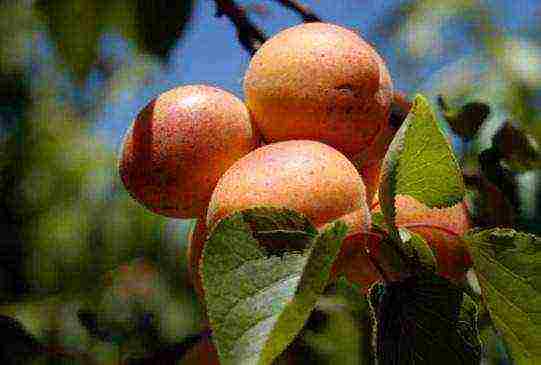
Early ripening, winter-hardy universal variety. The tree is medium-sized, fast-growing, with a paniculate raised crown of medium density. Begins fruiting in the 3rd year. Shoots are straight, dark red, glabrous. Leaves are wide, rounded or ovoid, short-pointed or long-pointed, dark green, smooth, shiny, with a crenate edge.
Fruits are round, with a yellow main and red integumentary color, with slight pubescence, with an average weight of 13 grams. The pulp is yellow, gristly, sweet and sour taste. The fruits contain: dry matter 13.2%, acid 1.8%, sugar 8.1%. Tasting score 3 points.
Average yieldb 43 c / ha.
The resistance to clotterosporium is average; aphids were damaged up to 1%.
Apricot variety Alyosha is included in the State Register for the Central Region.
Apricot Cupid, description
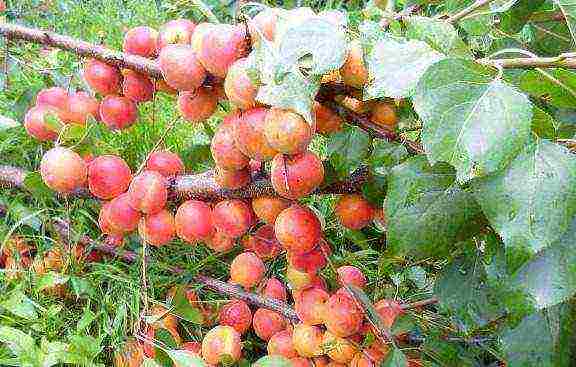
Medium ripening, table. Frost resistance is high. The yield is high. The crown is round, dense. The trunks are resistant to podoprevaniya and burns, but at a young age they are damaged by moniliosis, albeit to a weak extent. The burn resistance is satisfactory. The variety shows the best winter hardiness in elevated locations with well-drained soils, provided the roots are kept from getting wet.
The variety has a relatively high drought resistance. In the first half of summer, it satisfactorily tolerates a lack of moisture in the soil, completely preserves the leaves, fruit ovaries and gives a good annual growth. No death of leaves and branches due to drought was observed. The negative effect of excessive soil moisture on the death of roots was noted.
Trees are resistant to clasterosporium disease, fruits, like all varieties, are damaged by moniliosis in rainy weather. The flowers are relatively resistant to this disease.
The Cupid tree is slow-growing, compact, with a dense, round-elongated crown. The width of the crown at the age of 12 is 3-3.5 meters. The variety has a strong leafiness.
Trees enter the fruiting season in the third or fourth year of the scion's life, depending on the quality of the seedlings.
Fruit characteristics
Fruits are small, round, slightly elongated, weighing 32 grams. The side seam is shallow. The skin is yellow with a bright carmine blush. The funnel is shallow and wide. The top of the fruit is pointed. The skin is thin, velvety pubescent. The peduncle is very short, 3-5 mm long, thick. The pulp is orange, dense, tender, of medium juiciness. The taste is good, sweet and sour. The bone is separated. The seed is sweet.
Apricot variety Amur was included in the state register for the Far East region in 1979.
Distinctive features of this variety: round, compact crown, moderate growth. Strong foliage persists until leaves fall. Beautiful fruits with a blush, visible through the leaves, do not fall off when ripe. Red-burgundy buds and slightly pinkish flowers. The variety has well-defined characteristics.
Apricot Kichiginsky, variety description
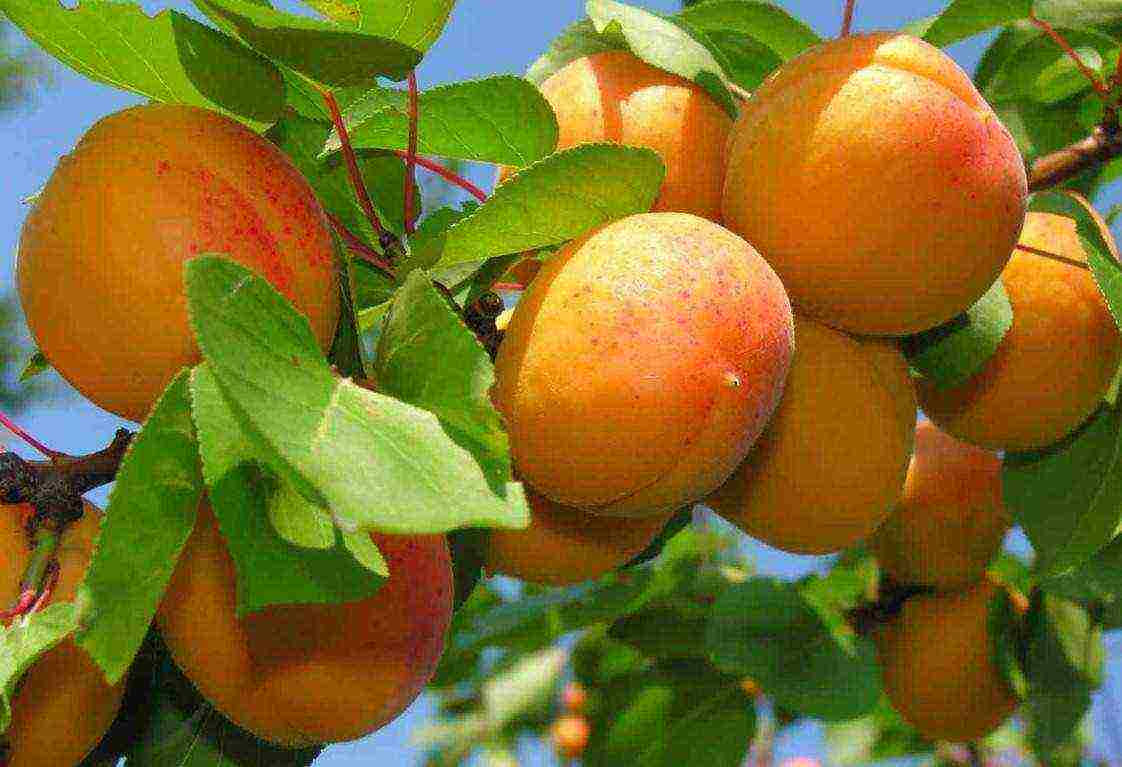
Mid-season variety for universal use. The tree is medium-sized, with a flat crown of medium density. Begins fruiting in the 5th year. Shoots of medium thickness, straight, dark red. The leaves are medium, rounded, dark green.
Fruits are round, yellow, with an average weight of 14 grams. The pulp is yellow, juicy, sweet and sour taste. Tasting score 4.5 points. The fruits contain: sugar 6.3%, acid 2.3%, vitamin C 7.6 mg /%.
The variety is self-fertile, winter hardiness is high.
Apricot variety Kichiginsky is included in the State Register for the Ural Region.
Apricot Red-cheeked, photo
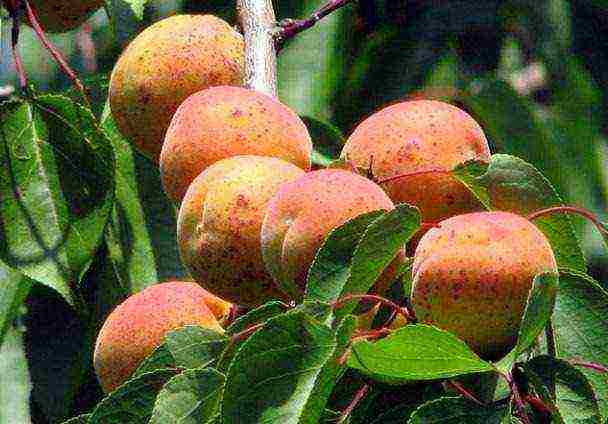
This apricot variety has been included in the State Register since 1947, therefore it has long been known among gardeners. It was originally grown in the North Caucasus and southern part of Russia, and although not included in the register for the Moscow region, in recent years it has been successfully grown in central Russia, the Moscow region.
Medium ripening, versatile, self-fertile variety. Winter hardiness is below average. Diseases are affected in a moderate degree. The yield is high.
The tree is vigorous. The crown is round, spreading, rare.
Fruits are large, weighing 50 grams, round or rounded-flat-ovate, very weakly compressed from the sides. The ventral suture is narrow, deep at the base. The skin is golden-orange with a reddish dotted blush, velvety pubescent, thin, dense. The pulp is light orange, dense, tender, aromatic, medium juiciness. The taste is sweet and sour, very good. The stone is large, separated. The seeds are sweet.
Apricot Lel, description
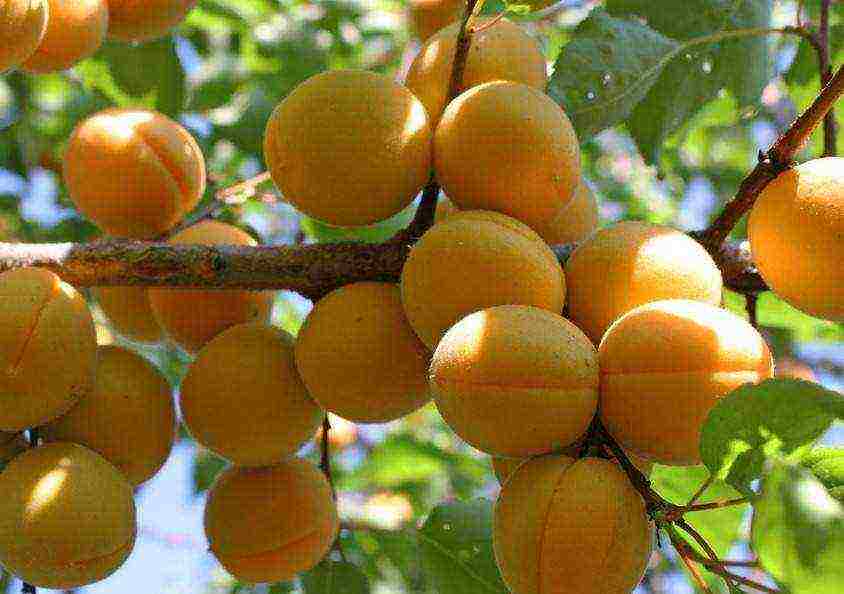
The winter-hardy variety Lel grows well and bears fruit in the climatic conditions of the Moscow region and the Moscow region. In these regions, there are almost no sudden changes in spring night temperatures, at which apricot flowers can freeze, and winter temperatures are stable here, in contrast to frequent temperature fluctuations in the southern regions. This reduces the risk of preheating the tree trunk during the thaw, therefore the Lel variety is considered one of the best for cultivation in these regions of the country.
The tree is medium-sized, reaching 3 meters in height. The dense light brown wood takes on darker shades in the center of the trunk. The tree is of moderate growth. Annual shoots of red-brown color darken with age. Weakly branched shoots form a neat compact crown in 3-4 years.
Dark green shiny ovoid leaves, smooth and soft to the touch. The short-pointed leaf blade is bordered with small denticles. The back of the sheet is matte. On the branches and annual shoots, the leaves are arranged alternately.
Single white-pink flowers sit tightly in the axils of the leaves. They have 5 rounded petals of regular shape and reach 3 cm in diameter. The flowers can withstand a drop in nighttime temperatures down to -1-1.5 ºС. The early flowering period (late April - early May) allows the tree to be an excellent honey plant.
Fruits are round, with an orange main and red integumentary color, with slight pubescence, with an average weight of 18 grams. The pulp is orange, tender, juicy, melting, sweet and sour taste.The fruits contain: dry matter 16.0%, acid 2.7%, sugar 9.0%. Tasting score 5 points.
Productivity of apricot Lel: up to 40 c / ha.
The resistance to clotterosporium is average; aphids were damaged up to 1%.
Apricot variety Lel was included in the State Register for the Central Region in 2004.
Apricot Favorite
Medium ripening, dessert variety. The tree is medium-sized, fast-growing, with a paniculate crown of medium density. Begins fruiting in the 3-4th year. Shoots of medium thickness, straight, dark red, glabrous. The leaves are large, ovate, long-pointed, dark green, dull, with a crenate smooth edge.
Fruits are cordate, yellow with red dots, with medium tomentose pubescence, with an average weight of 21 grams. The pulp is yellow, tender, mealy, sweet and sour taste. The fruits contain: dry matter 11.6%, sugar 6.1%, acid 2.1%, vitamin C 132.0 mg%. Tasting score 4.8 points.
Average yield: 18.8 c / ha.
Resistance to frost, pests and diseases is high.
Apricot variety Favorite was included in the State Register for the East Siberian region in 2008.
Monastic apricot, description
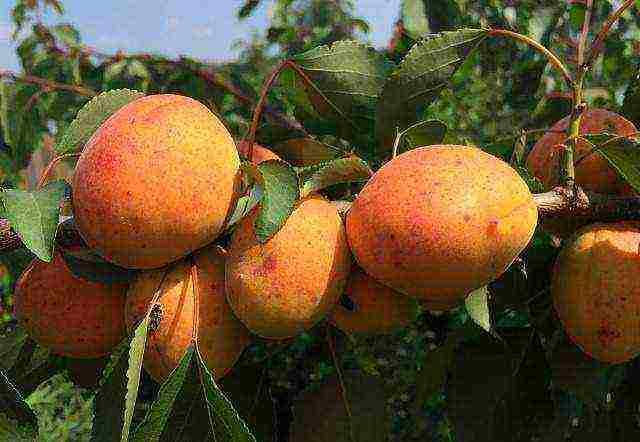
Monastyrskiy apricot variety is unpretentious in care, withstands frosts and gives abundant annual harvests.
Monastyrskiy apricot is obtained by free pollination of 3-4 own generation seedlings in the Main Botanical Garden. N.V. Tsitsin RAS in 1996. The author of the variety is L.A. Kramarenko. It has a wide zoning zone, entered in the State Register for the Central Region in 2004. Excellent characteristics and quick acclimatization make it possible to grow this variety in the cities of the Moscow region.
Late ripening, winter-hardy, versatile variety. The tree is medium-sized, fast-growing, with a spherical spreading crown of medium density. Begins fruiting in the 3rd year. Shoots are straight, brownish-yellowish, glabrous. The leaves are large, wide, ovate, long-pointed, dark green, smooth, shiny, with a crenate edge.
Fruits are round, with a yellow main and pink integumentary color, with slight pubescence, with an average weight of 22 grams. The pulp is yellow, juicy, mealy, sweet-sour taste. The fruits contain: dry matter 13.2%, acid 2.1%, sugar 8.0%. Tasting score 4 points.
Productivity of apricot variety Monastyrsky: up to 150 c / ha.
The resistance to clotterosporium is average; aphids were damaged up to 1%.
Apricot Orlovchanin, characteristic of the variety
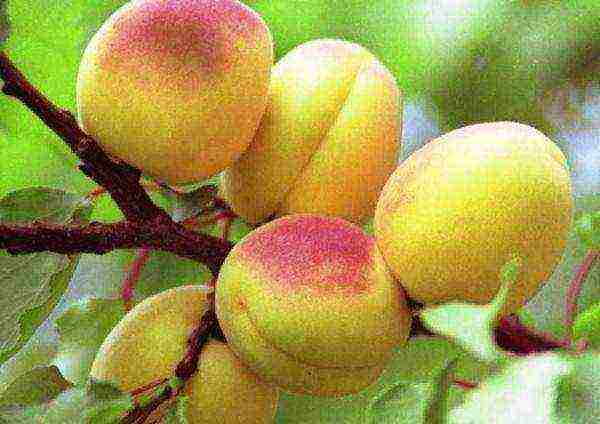
Mid-season, versatile variety. The tree is medium-sized with a spreading, raised crown of medium density. Begins fruiting in the 3rd year. Shoots are brown, naked. The leaves are large, wide, ovate, long-pointed, smooth, dull, with a double-toothed edge.
Fruits are flat-rounded-ovate with a yellow base and integumentary color, with slight pubescence, with an average weight of 33 grams. The pulp is yellow, mealy, sweet and sour taste. The fruits contain: dry matter 11.8%, sugar 6.2%, acid 1.9%, vitamin C 8.7 mg%. Tasting score 4.2 points. The stone separates well from the pulp.
Average yield 147 centners / ha.
Advantages of the variety: high frost resistance, resistance to klyasterosporiosis. Partially self-fertile.
The Apricot variety Orlovchanin is included in the State Register for the Central Black Earth Region.
Apricot Advertising, variety description
Table variety, medium late ripening. Selection of the Stavropol Experimental Station for Horticulture. Obtained from crossing of the selected form Zherdeli with the Krasnoshchekiy late variety. Zoned across the Stavropol Territory.
The tree is large, medium-sized, with a reverse-pyramidal crown of medium density, good foliage. Skeletal branches are long, of medium thickness, with an angle of origin of about 50 °. Shoots of medium length, slightly geniculate, reddish-brown. The leaf is large, wide, rounded, dark green, smooth, matte with a slight gloss. The flower is medium in size, single, the petals of the corolla are white with a light pink tint.Fruits are placed on one-year growth and shortened shoots (spurs).
Fruit characteristics
Fruits are large, one-dimensional, with an average weight of 40-45 grams, rounded-oval, slightly compressed from the sides, with a basic light yellow color. On the sunny side of the fruit, a pink blush appears with pronounced reddish-violet (carmine) dots covering 1/2 to 1/4 of the fruit's surface. The skin is of medium thickness, slightly pubescent, dull, cannot be removed from the fruit. The pulp is light yellow, juicy, slightly fibrous, of medium density, sweet and sour taste with an apricot aroma. The juice is colorless. The stone is medium in size, round-oval, well separated from the pulp. The seed is bitter, with a characteristic taste of amygdalin. The fruits contain 15.9% dry matter, 11.2% sugars, 19.4% vitamin C. The stem is short, thick, firmly attached to the stone.
Fruits of a medium late ripening period (at the end of July), 3-6 days later than Krasnoshchekiy, are distinguished by good transportability and versatility of use.
It blooms in an average time of 5-6 days, is self-fertile, the best pollinating varieties: Red-cheeked, Stavropol youth. The variety is fast-growing. Trees grafted on an apricot enter the fruiting season 3-4 years after planting.
Yield apricot varieties Reklamny at 5-6 years of age on average 35-40 kg per tree, at the age of 17-18 years from 70 to 93 kg per tree.
Winter hardiness of trees and flower buds is relatively high. Drought-resistant. Demanding on soil, light, heat and moisture. Responsive to fertilization. Requires the implementation of measures to protect against diseases and pests. More durable and yielding when cultivated on elevated relief elements. Formation on the improved low-tier crown. Due to the intensive growth, a limiting pruning is necessary with the subsequent transfer of the conductor to the lateral branch.
Advantages of the variety: early entry into the season of fruiting, high winter hardiness of flower buds, resistance to clasterosporia and monial burn, late ripening of fruits, their attractive appearance and high taste and canning qualities.
To the disadvantages varieties tallness, shrinking of fruits when overloaded with crops, bitter seed, self-infertility should be attributed, for normal fruiting, planting of pollinating varieties is required.
Apricot Samara, description, photo
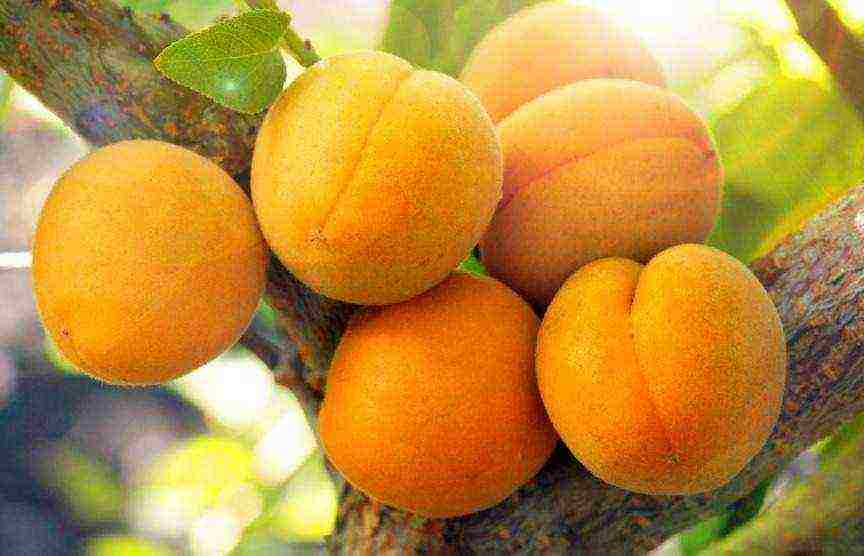
Late ripening, versatile, frost-resistant. The tree is medium-sized with a spreading crown of medium density. Begins fruiting in the 4th year. Shoots of medium thickness, straight, red-brown, glabrous. Leaves are ovate, long-pointed, dark green, smooth, with a finely serrated edge.
Flowering of this variety: May 1-3.
Fruits are one-dimensional, ovate, yellow, with slight pubescence, with an average weight of 17.6 g. The pulp is yellow-orange, juicy, dense, sweet and sour taste. The stone separates well from the pulp. Tasting score 4.4 points. The fruits contain: dry matter 13.1%, sugar 8.4%, acid 2.4%, vitamin C 13.8 mg%. The dates for harvesting fruits are August 7-12. The commercial and consumer qualities of the fruits are high. Fruits taken unripe are stored for up to 7-10 days. The transportability of apricots is high.
Yield at the age of 8 years is 15-20 kg per tree, at the age of 12-13 years - 40-50 kg. Fruiting is annual. Fruits firmly adhere to the tree, do not crumble when overripe.
Bred by A.N. Minin at the Samara zonal experimental station for gardening as a result of crossing the varieties Kuibyshev Jubilee with Kuibyshev early. Introduced into the State Register for the Middle Volga region in 2005.
Propagated by grafting onto seedling stocks of winter-hardy varieties: Skorospelki red, Ternoslivy Kuibyshevskaya, Vengerka Oktyabrskaya and clonal stock OPA-15-2.
Trees grow well on elevated areas of the western, southwestern, northwestern slopes, on soils of light and medium texture.
Formative pruning is necessary at a young age.During the period of full fruiting, the ends of the growths should be trimmed by one third; at old age, rejuvenating pruning should be carried out.
Advantages of the variety: high winter hardiness of wood and flower buds, high annual yield, high quality fruits.
Disadvantages of the Samarsky variety: insufficiently large fruits.
Apricot Saratov ruby, description, photo
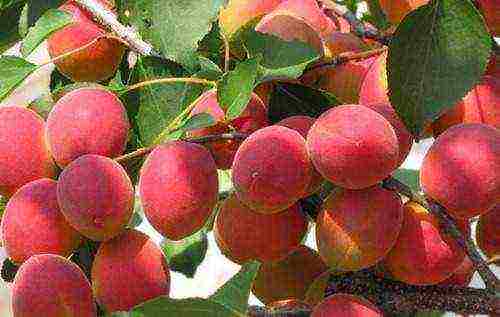
The hybrid demonstrates the best yield, of course, in its native Saratov region. Reviews from other regions are not always unambiguous, so we can say that it is still being tested.
A variety of medium ripening, universal use. The tree is medium-sized, fast-growing, with a spherical, spreading crown of medium density. Preferential placement of fruit formations on annual shoots, fruit twigs and spurs. The bark is flaky, brown. Shoots are medium, straight, brownish-brown, glabrous. There are few lentils, they are small, yellow-gray. Leaves are medium, wide-rounded, long-pointed, dark green, smooth, shiny. The leaf blade is concave, curved downward, sharply pointed, the base of the leaf is dull, there is no pubescence. The edge of the leaf is crenate. The petiole is medium. 2-3 pieces of iron, they are yellow, oval. Flowers in the inflorescence are medium, white, solitary.
Fruits are medium in size, elliptical in shape, with an average weight of 42 grams. The main color of the fruit is light orange, the integumentary color is carmine, blurred over most of the fruit. The skin is medium-rough, with velvety pubescence, it is difficult to remove from the fruit. The pulp is orange, medium juiciness. The juice is colorless. The taste is sweet and sour. Tasting score 4.3 points. The content of dry matter in fruits is 14.2%, sugar 8.5%, acid 1.5%, pectin substances 1.33%, vitamin C 12.3 mg%. The stone is small, elliptical, slightly pointed, smooth, well separated from the pulp.
Average yield 338 centners / ha.
The variety is resistant to moniliosis and clasterosporiosis.
The apricot variety Saratov Ruby is included in the State Register for the Lower Volga Region and is recommended for testing in the North Caucasus region in 2015.
Apricot Sibiryak Baikalova, variety description
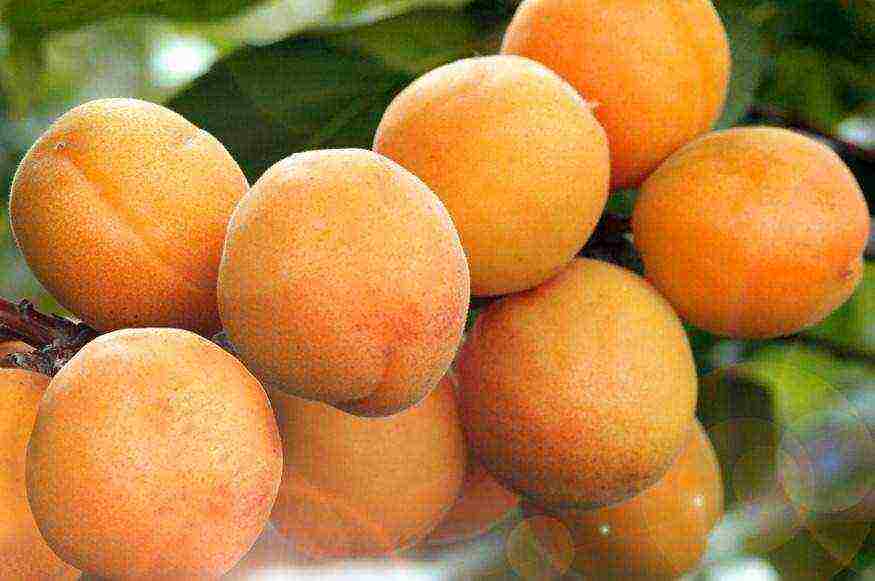
A versatile, frost-resistant variety, early ripening. The tree is medium-sized with a spherical spreading crown of medium density. Begins fruiting in the 3rd year. Shoots are thick, straight, red. Leaves are ovoid, dark green, dull, with a coarsely serrated edge.
Fruits are oval, orange, with a slight blush and medium pubescence, with an average weight of 27 g. Orange pulp, fibrous, sweet taste. Tasting score 4.8 points. The fruits contain: dry matter 15.8%, sugar 7.1%, acid 2.4%, vitamin C 8.1 mg /%.
Average yield 75 kg / ha.
The Sibiryak Baikalova variety was included in the State Register for the East Siberian region in 2002.
Apricot Son of Krasnoshchekiy, description, reviews
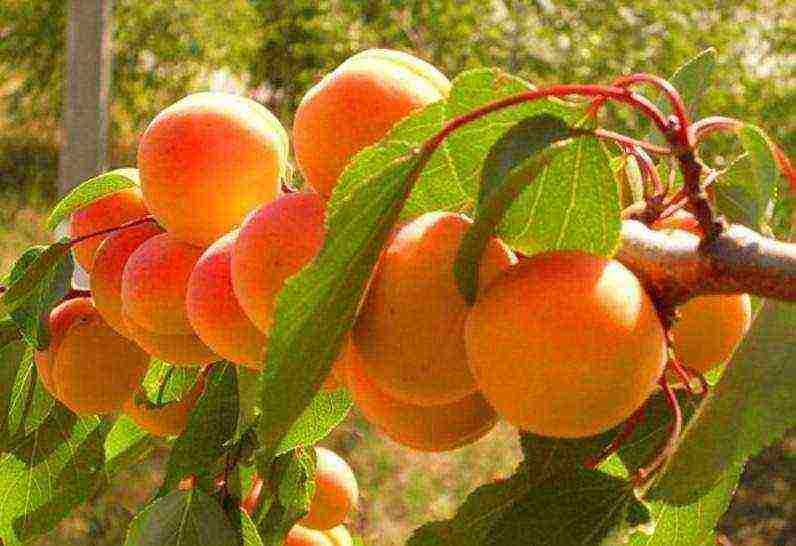
The variety was bred at the Rossosh zonal experimental gardening station by M.M. Ulyanishchev from crossing the varieties Golden Summer and Krasnoshekiy. Since 1974, the variety has been zoned in the Astrakhan region. Currently included in the State Register for the Lower Volga region.
The tree is medium to vigorous, with an oval or broadly oval raised dense crown with good foliage. The leaf blade is rounded, with a shortly pointed apex and often curled to one side and a heart-shaped base. The petiole is long, 20-40 mm long, of medium thickness, glabrous, with a bright burgundy anthocyanin coloration on top. The flowers are large, 25-30 mm in diameter, pure white, blossoming from pure white buds.
Fruit characteristics
Fruits with an average weight of 30-35 grams, height 40-45 mm, width 37-38 mm, thickness 34-35 mm, the largest fruits reach a weight of 55-60 grams, oval or round-oval, slightly or moderately flattened from the sides , rather regular, although often the abdominal half is slightly more massive than the dorsal half, the apex of the fruit is rounded, usually with a very small toe at the end of the abdominal suture, the suture is narrow, of medium depth.Orange peel, with a blurred orange-red blush on the sunny side, average pubescence. The stone is medium, weighing 2-3 grams, which is 6.5-8.5% of the fruit weight, oval, the apex is wide-rounded, the base is narrow-rounded, the dorsal suture is closed, the abdominal suture is narrow or of medium width, the central rib is well pronounced , acute, lateral ribs are also well expressed, much more blunt than the central one; the surface of the bone is bumpy, but smooth, the color of the fresh bone is brown; the bone lies in a large cavity, free, the core is bitter. The pulp is bright orange, rather dense, of a solid consistency, juicy, sweet with a light pleasant acid and barely perceptible bitterness, no powdery taste, with a pleasant apricot aroma, the tasting score is high - 4.7 points.
The fruits are used both for fresh consumption and processing. The compotes are of good quality with an overall rating of 4 points (4.1 points for appearance and 3.7 points for taste).
Flowering occurs in the middle or late period. Ripening in the middle period, in the south of the Central Black Earth Region at the end of the second - beginning of the third decade of July. Trees begin to bear fruit in 4-5 years, early maturity is good.
Advantages of the variety: large beautiful fruits of good taste, a sufficient level of adaptation of the tree to the conditions of the south of the Central Black Earth Region.
Disadvantages of the Son Krasnoshchekiy variety:irregular yield due to freezing of flower buds.
Apricot Favorite, variety description
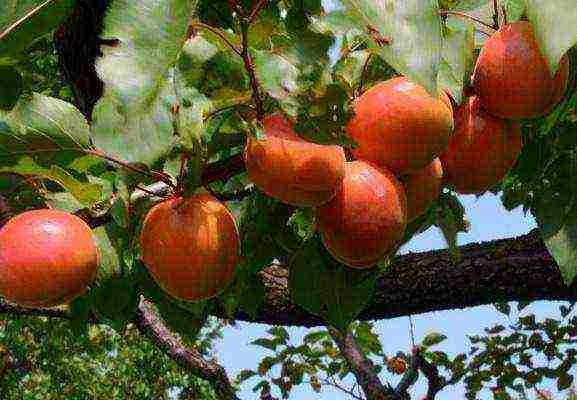
Late ripening, winter-hardy, versatile variety. The tree is medium-sized with a spreading, spreading, sparse crown, 3-4 meters high. Begins fruiting in the 3rd year. Shoots are straight, dark red, glabrous. The leaves are large, wide, ovate, long-pointed, dark green, smooth, shiny, with a crenate edge.
Fruits are round or ovoid, with a yellow and red integumentary color, with a large dense blush, with slight pubescence, with an average weight of 30 grams. The pulp is orange, juicy, gristly, melting, sweet-sour taste. Tasting score 4.5 points.
Yield: 30 c / ha.
The Favorit variety was included in the State Register in 2004 for the Central Region.
Disadvantage this variety, like the Monastyrsky, is the late ripening of the fruits. In years with cold rainy summers, the fruits do not have time to ripen and remain unripe on trees in September.
Apricot Khabarovsk, description
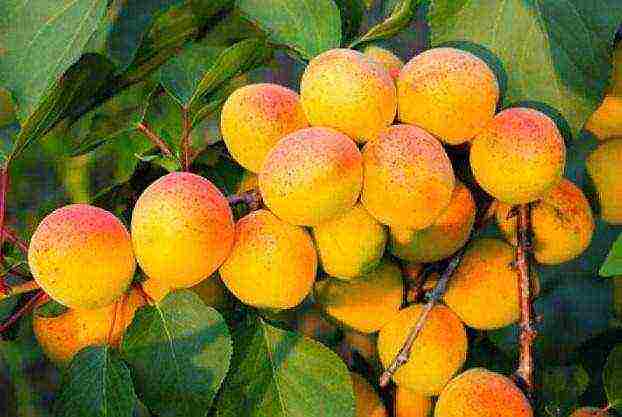
Early maturing, winter-hardy, disease-resistant, fruitful apricot variety. ripening period.
The tree is vigorous, reaching large sizes. At the age of 10, its height is 4.8 m, width is 5.1 m. The crown is rare, spreading. Leaves are of medium size, elongated-oval, with a sharp long end. The flowers are large, white. The shape of the petal is rounded.
Trees begin to bear fruit in the fourth, fifth year of the scion's life. The variety is capable of annual sustainable fruiting. Fruits ripen on July 28-30. The maximum yield per tree is 36.6 kg.
Characteristics of Khabarovsk apricot fruits
Fruits are large, average weight 30 grams, maximum 45 grams. The shape is rounded-conical, slightly compressed from the sides. The apex of the fruit is pointed, the lower fossa is deep. The seam is wide and deep. The surface of the fruit is bumpy, strongly pubescent, the skin is not peeling. The color is pale green, integumentary in the form of a continuous, and in some places a dotted orange-red blush. The pulp is thick, medium juiciness, yellow-orange color, pleasant sweetish-sour taste. The fruits contain 12.3% sugars, 2.1% malic acid, 7.9% vitamin C, 16.1% dry matter. By taste, a variety for table purposes. The transportability of the fruits is average. Fruit tasting score 4 points. A stone weighing 1.2 g, round-elongated in shape, with grooves, well behind the pulp. The kernel is sweet.
The variety is resistant to drought and waterlogging. Relatively resistant to moniliosis and clasterosporium. It is damaged by the moth to a small extent.
Dignity varieties: large fruits for table use, good presentation, high annual yield. A pit with a sweet core. It is widely used for seed propagation.
Flaws: poor winter hardiness in low locations, insufficient fruit transportability.
Apricot variety Khabarovsk was included in the state register in 1979 for the Far East (Primorsky Territory) region.
Apricot Tsarsky, description, photo
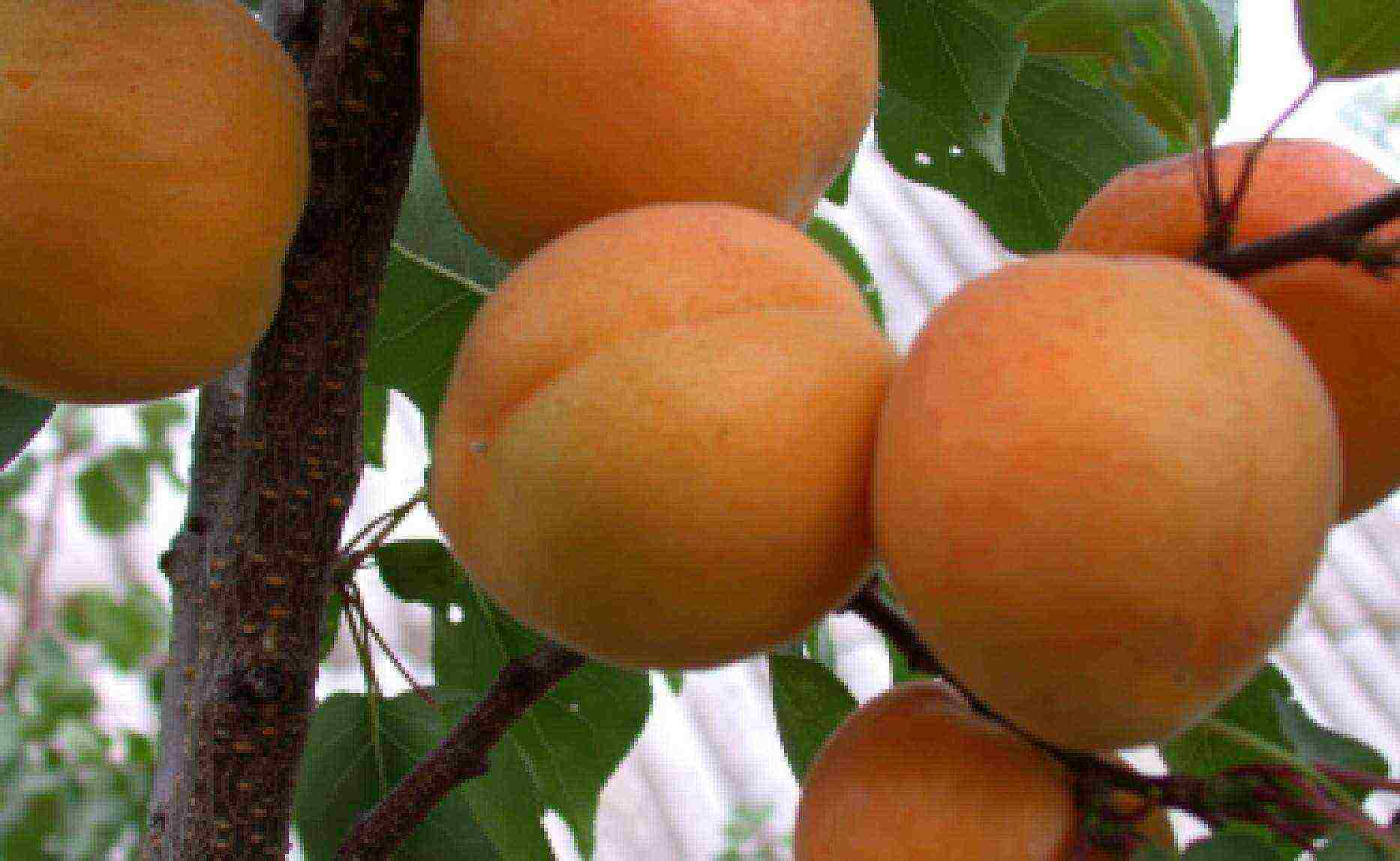
Early ripening, versatile, winter-hardy variety. The tree is medium-sized, slow-growing, with a paniculate raised crown of medium density. Begins fruiting in the 3rd year. Shoots are straight, dark red, glabrous. The leaves are wide, rounded or ovoid, short-pointed, dark green, smooth, shiny, with a crenate edge.
Fruits are round, with a yellow-orange main and red-pink integumentary color, with slight pubescence, with an average weight of 15 grams. The pulp is orange, tender, juicy, melting, sweet-sour taste. The fruits contain: dry matter 17.8%, acid 1.7%, sugar 8.5%. Tasting score 4 points. The fruits of the variety are suitable for fresh consumption, and high quality jams and compotes. The keeping quality of the variety is good.
Average yield 30 c / ha. The yield is average, but stable. The grafted plants enter fruiting 3-4 years after grafting.
The Tsarsky apricot variety was included in the State Register for the Central Region in 2004.
Apricot Black velvet, description, photo
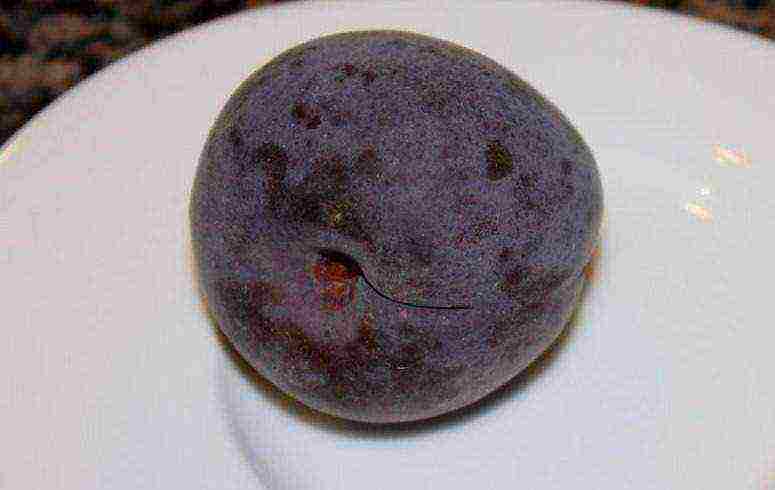
A variety of medium ripening, winter-hardy, universal. Wood average vigor. The crown is flat-rounded, of medium density.
Fruits are medium in size - 30 g, dark purple, pubescent. The pulp is yellow, pink at the skin, medium density, juicy, sweet-sour, aromatic, very good taste. The stone is medium in size, separating. The fruits ripen at the end of July, are transportable, suitable for fresh consumption and very good for canning.
The variety is partially self-fertile. Winter hardiness is high, at the level of winter-hardy cherry plum varieties. Drought resistance is average. Resistant to moniliosis, clasterosporium disease, bacteriosis, cytosporosis.
Advantages of the variety: high quality fruit, productivity, adaptability.
Flaws: insufficiently large fruits.
Apricot variety Black Velvet is included in the State Register for the North Caucasus region.
Apricot Triumph North, photo
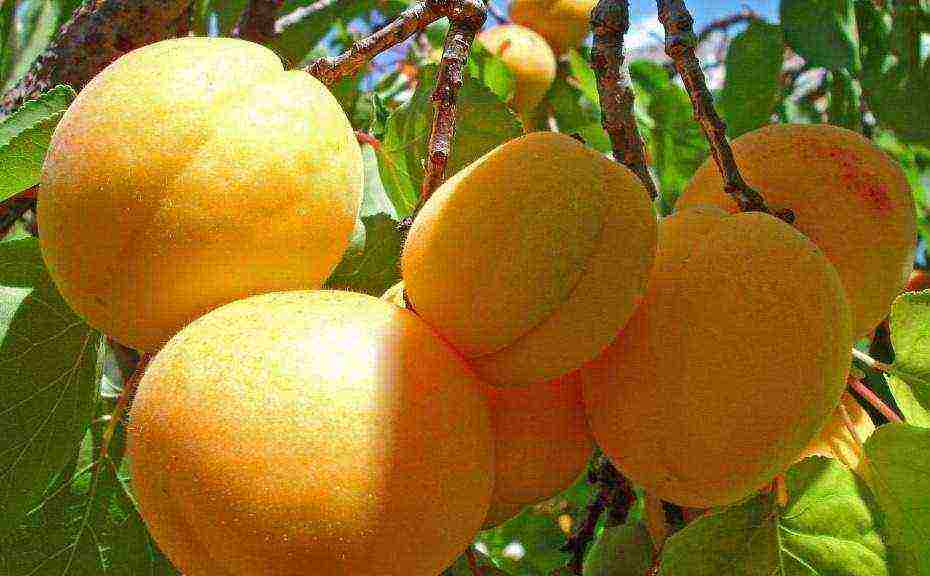
Obtained from crossing the famous ancient southern variety Krasnoshchekiy and a seedling of the Trans-Baikal apricot Severny early. Author A.N. Venyaminov. It was zoned in the south of the Central Black Earth Zone.
The tree is vigorous, the crown is spreading. The branching is average. Skeletal branches are thick, branch off at an angle of 45 degrees or more. The leaves are large and pointed.
Round-oval apricots. The average fruit weight is 55 grams. The peel is pubescent, of medium thickness, sourish. The color at full maturity is yellow-orange with green on the shady side. Cover color in the form of a continuous blurred or deep red dense blush. The pulp is orange, juicy, tender, melting, pleasant sweet taste. The kernel is sweet. The variety is suitable for fresh consumption.
Apricots of this variety ripen in late July - early August. The first fruiting occurs in the 4th year of the tree's life in the garden. Harvesting intensively.
Apricot yield Triumph North: up to 64 kg of fruits from 1 tree.
Winter hardiness of wood is high, flower buds are medium. Disease resistant.
The apricot variety Triumph North is not included in the State Register of the Russian Federation.
If you grow any of these varieties of apricots, please write what characteristics are most important to you. What is the yield from 1 tree in your conditions?
Your feedback on the varieties of apricots will help many amateur gardeners to plant seedlings of the best varieties in their area.
Also, please indicate in which region you grow your wonderful trees. Thank you!
Self-fertile apricot varieties are often chosen for growing in small backyards where there is no opportunity to plant many trees. They bear fruit every year, regardless of whether there are pollinators nearby, as they pollinate themselves. Below will be listed the best self-fertile apricot varieties with descriptions and photos for growing in small areas and large orchards with.
The most productive self-fertile varieties of apricot
Self-fertile apricot varieties do not give the same yield as ordinary, not self-fertile, but there are a number of varieties in this category that are distinguished by good fruiting annually.
- "Pineapple" an apricot gives annually up to 145 kg of fruits from one tree! Apricots ripen around the middle of summer. Fruits of the "Pineapple" variety are up to 50 g, the shape is uneven - rounded, but bumpy. The stone is small, the color is yellow apricot with a red barrel. The pulp is fibrous, light yellow, with a high content of juice and sugar. It is used more often fresh, as it can lose its taste when preserved. The variety is prone to shedding, frost resistance only up to -25 degrees.
- "Red-cheeked" ripens around mid-July. The first fruits are children 3-4 years after planting. The yield, when compared with other self-fertile varieties, is high - up to 100 kg of apricots are removed from the tree every year. Fruits up to 50 g, oval, orange in color with raspberry "cheeks". The peel of Krasnoshchekiy's apricot is dense, but not thick, velvety. The stone is well separated from the pulp, small in size, occupies only 6.2% of the total weight of the fruit. The taste is sweet, full-bodied, the acidity is almost inaudible. It contains up to 9.8% sugars and 1.36% acid. Main disadvantages: it does not tolerate high humidity and requires constant care.
- "Melitopol early" ripens around mid-summer. The yield can reach 55 kg / ha for industrial cultivation or 100 kg / tree. It grows up to 5-6 meters in height, needs regular pruning and maintenance. Fruits up to 40 g, oval, yellow-orange, with a small number of subcutaneous points. The taste is sweet, slightly tart, the flesh is soft, orange in color. The rind is very thin, velvety. The use of the fruits is universal, however, the fruits cannot be transported - they are very soft after ripening.
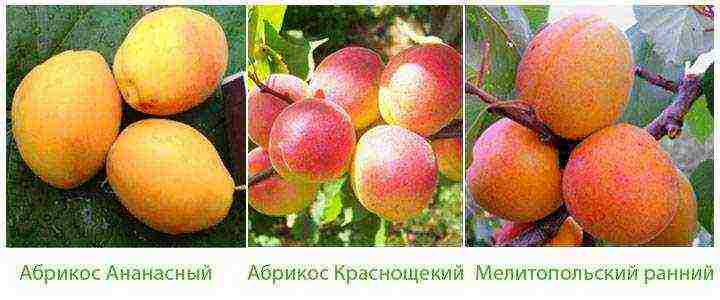
Photo of self-fertile varieties of apricot
What self-fertile varieties are frost-resistant?
In the middle and northern regions, where the climate, and especially winters, is unpredictable, it is necessary to plant frost-resistant self-fertile apricot varieties.
- «Northern triumph»Grows up to 4 meters in height. Differs in increased frost resistance, it is grown even in the northern regions of Russia. The weight of the fruits reaches 60 g. The shape is oval, the color of the peel is yellow with pink spots on the surface, the pubescence is weak. The flesh of the Triumph of the North is sweet and sour, juicy. Among the shortcomings, there is an average yield of 50-60 kg, unstable fruiting, as well as the fact that the first harvest can be obtained only in the 5th year of the planting field.
- «Tsarsky"- an early maturing self-fertile variety of apricot. Frost resistance up to -40 degrees Celsius. The tree grows up to 4 meters, the first fruits appear at about 4 years. Productivity from a tree up to 30 kg. Fruits of 20-30 g, yellow, with a red blush. The pulp is sweet and sour. Among the shortcomings, it should be noted that small fruits and the fact that the bone is poorly separated from the pulp.
- «Sardonyx"- mid-season variety. Withstands frosts down to -33.7 degrees Celsius. Fruit ripening is observed at the beginning of August. The tree is of medium height, fast-growing, the first harvest is harvested 4 years after planting. The weight of the oval fruits is up to 50 g, the peel is orange, the flesh is lighter. The taste is sweet, the fruits are versatile.
- «Hardy"- late self-fertile apricot variety. Provides consistently high yields. The tree is tall, vigorous, the crown is slightly branched, needs shaping. Fruiting from 5-6 years, yield up to 60 kg / tree. Increased winter hardiness, there is an average disease resistance.But it should be borne in mind that the variety is often affected by moniliosis, and therefore requires regular processing. Abricoski weigh in the range of 30-40 g, rounded and flattened on both sides. The peel is yellow-orange, dense, pubescence is weak. The taste is sweet, rich, sugary.
Apricot varieties for the Moscow region are famous for their good winter hardiness.
Unpretentious self-fertile apricot varieties
Unpretentious self-fertile varieties of apricots are very easy to grow. They practically do not require maintenance, they grow quickly. The main thing is just to water them sometimes, to feed them at least once a year and to harvest on time.
- «Dessert»Apricots are grown even by young, inexperienced gardeners. It grows quickly and requires almost no maintenance. The tree is of medium size, the crown is sparse, round in shape. Fruits up to 40 grams, round, slightly flattened on both sides. The peel is strongly pubescent, yellow. The pulp is light orange, not very dense, juicy, sweet, but sour. Has a strong aroma.
- «Snegirek»Has high frost resistance. The tree grows only up to 1.5 meters, which makes it much easier to care for. The yield from a tree is within 10 kg, but it happens even more, depending on the region of cultivation. In southern cities, yields can reach up to 20 kg per season. Ripening occurs around mid-August. The fruits are dense, beautiful, easy to transport. Weight only 15-20 g, cream color with burgundy blush.
- «Lel»Self-fertile variety of early ripening apricot. Trees grow up to 3 meters in height, the crown is round. The first apricots give 3-4 years after planting. Up to 20 kg of fruits are removed from the tree annually, but if additional pollinators are planted nearby, it will increase 2-3 times. The apricots are orange, weighing within 20 g. The pulp is sweet, almost without acid after full ripening. The bone comes off well from the pulp. Ripening occurs around the end of July. Delivers frosts down to -30 degrees.
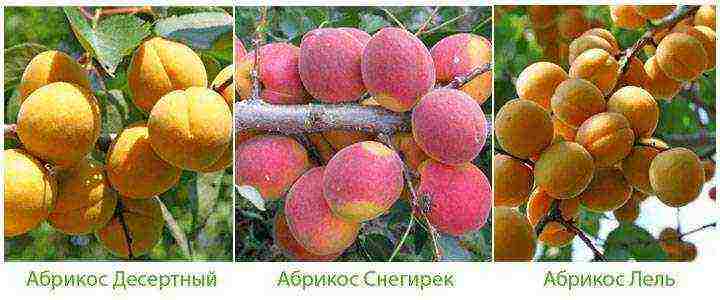
Self-fertile varieties of apricot
The best partially self-fertile apricot varieties
In addition to self-fertile apricot varieties, there are also partially self-fertile varieties that can bear fruit without pollinators, but only in small quantities. They give large yields only when there is a suitable pollinator nearby. Such varieties are most often used for planting if the fruits are used for personal consumption and not for sale.
- «Polesie large-fruited apricot"Gives apricot up to 115 kg from each tree per year in the presence of additional pollinators (varieties" Amur "," Khabarovsk "), otherwise the yield is reduced by 2 times. The variety is mid-season, the first fruits are observed for 3-4 years. The fruits are sweet and sour, weighing up to 55 g, oval in shape, the color of the fruit is orange with a scarlet blush. It is easy to separate the bone from the pulp, so the variety is popular in processing.
- «Veteran of Sevastopol»Is a late, partially self-fertile apricot variety, ripening around mid-August. Created at the Research Institute of Horticulture in Ukraine. Fast-growing, fruits begin to ripen from 3-4 years. The tree is not very tall, the crown is compact. Resistance to winter and spring frosts is high. Fruits weighing up to 65 g, there are also champions under 85 g, but this is a rarity. The shape is oval, squeezed from the sides. The color of the peel is golden, with a blush. The taste is sweet, with sourness, which only emphasizes the delicate taste.
- «Lutezhsky" or "Kiev red-cheeked»Belongs to the mid-early group of apricots. Fruiting from 3-4 years, partially self-fertile, for higher yields, it is necessary to sow pollinators nearby. The winter hardiness of the tree and its flower buds is excellent. Medium resistant to diseases. Apricots up to 50 g, rounded-oval, slightly flattened from the sides. The peel is yellow-orange, with a blush on one or both sides. The pulp is light yellow, the taste is delicate, sweet. The bone is easily separated from the pulp.
- «Siren"- a variety bred by Romanian breeders. Popular and in demand in Romania and abroad.Fruits are oval, elongated, rounded, weighing 50-60 g. Orange peel with red cheeks. The first crop can be harvested for 4 years.

